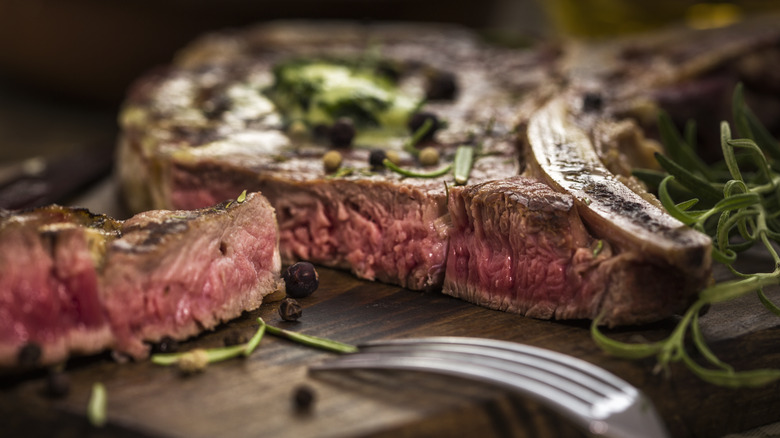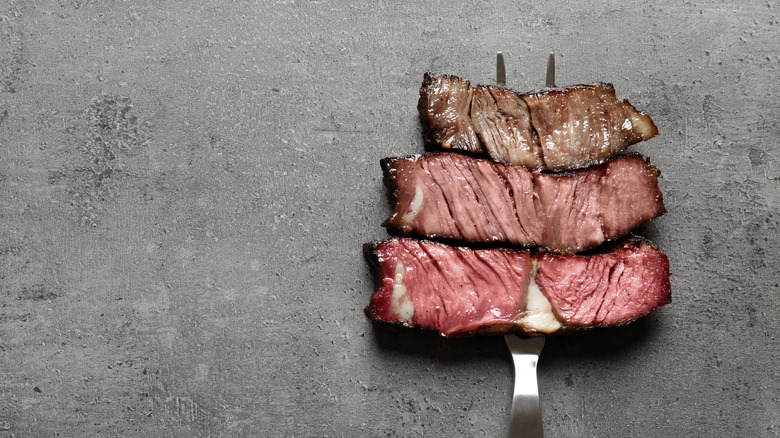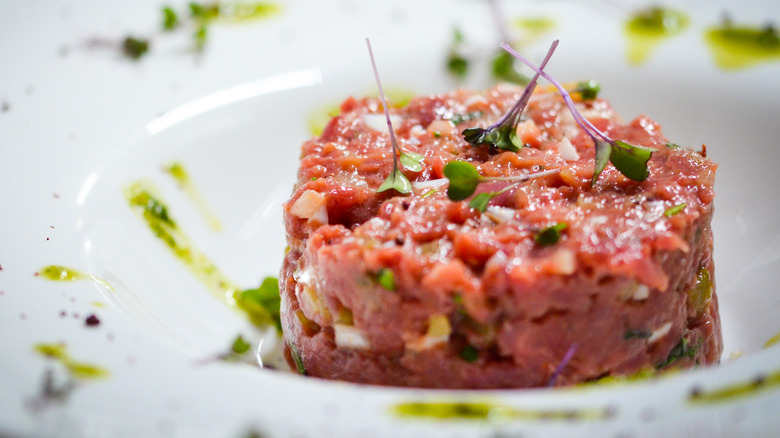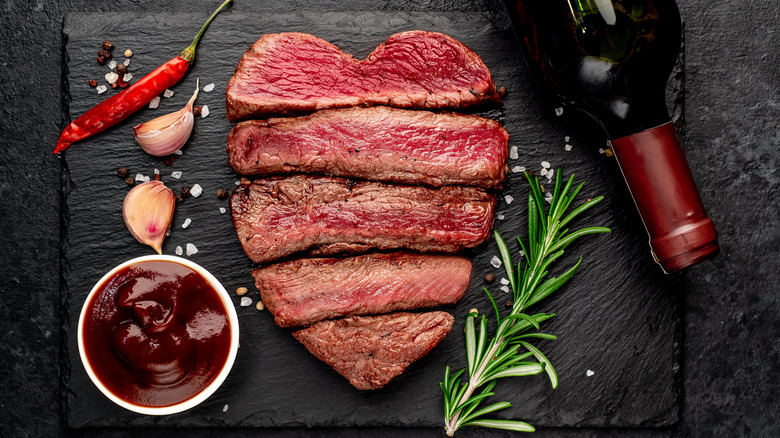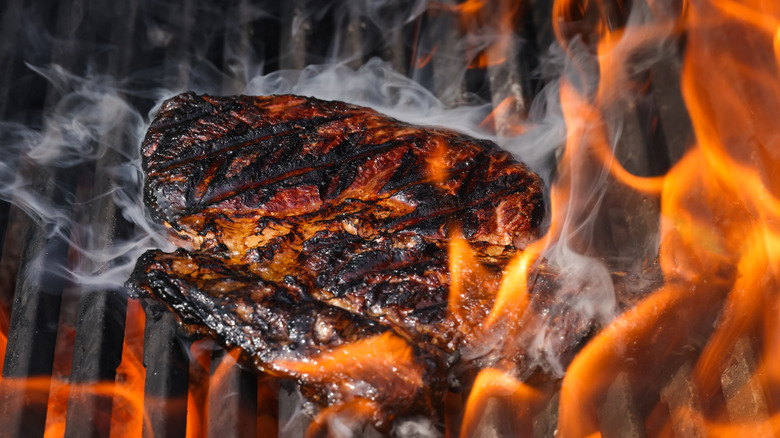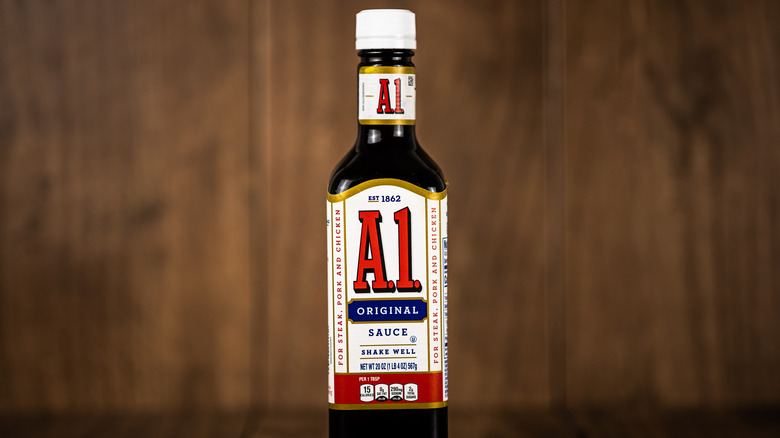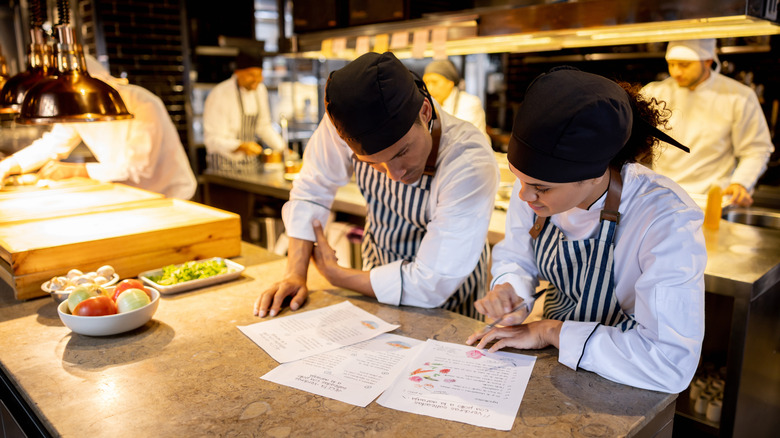Words And Phrases You Should Avoid When Ordering Steak
Enjoying steak is often considered a luxury. Not only does it tend to be a bit on the pricey side, but the meat itself is rich and sumptuous, thanks to its dense, beefy flavor. While many of us certainly enjoy grilling steak at home, there's no denying how nice it can be to let a restaurant do all the cooking.
However, there are certain words and phrases you should avoid when ordering steak at a restaurant. Granted, diners are entitled to make certain requests within reason — but it's still a good idea to be aware of some basic expectations and unspoken understandings.
All of us have certain blindspots in different areas of life; the more nuanced intricacies of ordering certain types of food are certainly no exception. Being more familiar with what's acceptable and what's generally frowned upon can help create a smoother dining experience for everyone involved — and possibly prevent some subtle judgment or disapproval.
Plus
You might already be aware that steak doneness can be cooked to several different temperature requests, including rare, medium-rare, medium, medium well, and well-done. There is another temperature that some restaurants may also offer — blue — which is the least cooked that a steak can be ordered, apart from being completely raw. Yet there's another word that some diners may use when ordering steak that's typically not very well-received at restaurants. And that word is plus.
Order a steak temperature plus is essentially requesting it to be cooked just a tad over a certain temperature. For example, ask for a steak to be cooked medium-rare plus, meaning a little more cooked than medium-rare but not cooked quite medium. Not only is this pretty much pointless as a medium-rare plus steak is basically just medium, but it's bound to trigger some mild frustration from servers and cooks. It's better to just keep it simple and select one of the five main temperatures that everyone else requests.
Cooked tartare
For the uninitiated, steak tartare is basically just minced, high-quality raw beef. The dish is open to interpretation but often eaten with crostini or crispy chips and typically features an egg yolk along with some herbs for extra color and flavor. Tartare often gets drizzled with something acidic, like fresh lemon juice, and mixed with capers, diced green onions, or chopped chili peppers. The end result is rich, tender and a little tangy, depending on what it's mixed with.
Tartare is prepared with raw beef, and it's meant to be eaten that way. When diners ask servers for cooked beef tartare, it's like asking for cooked sashimi at a sushi restaurant — you're bound to get some confused looks, and your request will most likely be denied. If you're squeamish about consuming raw beef, that's totally fine. But if that's the case, you should probably just avoid ordering tartare altogether and stick to a cheeseburger or something else that's going to actually get cooked on the grill.
In a rush
Whether due to unexpected emergencies or just poor time management, we all have those days when we're in a rush. That said, generally speaking, we can't really expect others to cater to our dilemma — especially when we're ordering at a restaurant. At the end of the day, claiming to be in a rush doesn't entitle anyone to preferential treatment over other diners and customers. Considering that steak takes more time to prepare compared to smaller menu items, it also doesn't really make much sense to order it if you're truly pressed for time.
Telling a restaurant that you're in a rush insinuates that you want your order to be prioritized over those of other guests, which is a good way to offend just about everyone around you. If you're in a rush, then your food order should reflect that. Instead of a steak, order something that's quick to prepare, like a simple salad or a sandwich. Expecting the kitchen to give your food preferential treatment and rush you out an order of steak reeks of self-importance. It's not just inconsiderate; it's also just unrealistic — cooking a thick cut of meat that often comes with several sides takes time, not to mention the rest time that meat needs after cooking.
Two temperatures
It should be understood that asking for a single steak to be divided into multiple pieces and then cooked at different temperatures is an unreasonable request. Making a request like this is unlikely to be welcomed because it's not very cost-effective for a restaurant to divvy up an expensive single cut of steak and prepare it in different ways, all for a single price.
If you want two different temperatures for your steak, then you should just order two separate steaks. If that sounds like too much food, then pick the temperature that you most prefer. At the end of the day, if you really have these kinds of preferences, it may be best to just get your own steaks from a butcher or grocery store and then prepare them however you'd like at home. But expecting a restaurant to cut you a deal like this on a single steak is a bit absurd — and it's bound to get you some eye-rolls.
Well-done
We all have different tastes when it comes to food, and that's perfectly fine. Everyone is free to have their own preferences, and there's nothing wrong with eating food that's been prepared the way that you like it. Above all else, food is meant to be enjoyed.
That said, there is something particularly curious about ordering a high-quality cut of steak cooked well-done. A big part of the joy of eating steak is savoring its juicy succulence. When steak is cooked well-done, the beef tends to be tougher and chewier, having lost much of its tenderness from being cooked for a longer period of time.
If you really enjoy well-done beef, it's probably a lot cheaper to order a cheeseburger than to order a steak. It's a little difficult to wrap our heads around the concept of ordering an expensive cut of meat that's been charred to oblivion — but to each their own.
Extra steak sauce
Sometimes steak comes with a sauce, like a béarnaise. But if you're at a nice steakhouse, you probably won't find many people dipping their steaks in grocery store variety sauces like A1 or ketchup. It's generally frowned upon to slather a nice steak with something like A1 or ketchup because they overpower the taste of the steak and mask the nuances of the marbling.
Because A.1. is mostly made with tomato purée, vinegar, corn syrup, and salt, it has an intense flavor that dominates everything it touches. It's more common to see A.1. used on cheaper cuts of steak that are a little tougher and less flavorful. So, while it may be normal to use something like A.1. on bargain steaks at home, some nicer steakhouses may be borderline insulted at the notion of their high-end steaks getting slathered in it. It's probably best to leave that kind of stuff at home.
Not on the menu
Believe it or not, rather than ordering from steaks that are advertised on the menu, some diners inquire about steaks that aren't even listed. While it's commonplace for restaurants to run limited-time specials to test out new recipes with diners, it's far less common for restaurants to keep a secret stash of food off the menu that's completely unadvertised. Asking for a cut of steak that's not on the menu is generally a waste of time; very rarely will a restaurant invest in buying cuts of steak that it's not openly selling to customers.
Rather than asking for something that's not on the menu, it's a much better idea to ask if there are any specials that day. Specials may be written on separate boards in the restaurant but may not be actually printed in the restaurant's regular menu. Better yet, if you're craving a particular cut of steak, do some menu research ahead of time and seek out a restaurant that serves it.
